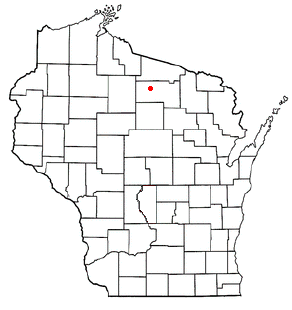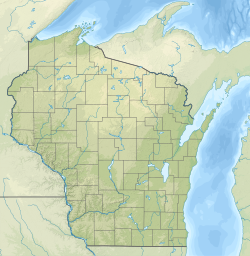
Oneida County is a county in the state of Wisconsin, United States. At the 2020 census, the population was 37,845. Its county seat is Rhinelander.

Lincoln County is a county located in the U.S. state of Wisconsin. As of the 2020 census, the population was 28,415. Its county seat is Merrill. The county was created in 1875 and named after President Abraham Lincoln.

Brown County is a county in the U.S. state of Wisconsin. As of the 2020 census, the population was 268,740, making it the fourth-most populous county in Wisconsin. The county seat is Green Bay. Brown County is part of the Green Bay, WI Metropolitan Statistical Area.

De Pere is a city in Brown County, Wisconsin, United States. The population was 25,410 at the 2020 census. De Pere is part of the Green Bay Metropolitan Statistical Area.

King is a town in Lincoln County, Wisconsin, United States. The population was 855 at the 2010 census.

Cassian is a town in Oneida County, Wisconsin, United States. The population was 962 at the 2000 census. The unincorporated communities of Goodnow and Harshaw are located in the town.

Hazelhurst is a town in Oneida County, Wisconsin, United States. The population was 1,258 at the 2018 census. The unincorporated community of Hazelhurst is located in the town.

Lake Tomahawk is a town in Oneida County, Wisconsin, United States named for the adjacent freshwater lake of the same name. The population was 1,160 at the 2000 census. The census-designated place of Lake Tomahawk and the unincorporated community of Sunflower are located in the town.

Little Rice is a town in Oneida County, Wisconsin, United States. The population was 314 at the 2000 census. The unincorporated community of McCord is located in the town.

Lynne is a town in Oneida County, Wisconsin, United States. The population was 210 at the 2000 census. The unincorporated communities of Clifford and Tripoli are located partially in the town.

Monico is a town in Oneida County, Wisconsin, United States. The population was 260 at the 2020 census. The unincorporated community of Monico is located in the town.

Newbold is a town in Oneida County, Wisconsin, United States. The population was 2,710 at the 2000 census. Tom Doyle Lake and the unincorporated communities of McNaughton and Newbold are located in the town.

Nokomis is a town in Oneida County, Wisconsin, United States. The population was 1,371 at the 2010 census.

Pine Lake is a town in Oneida County, Wisconsin. The population was 2,720 at the time of the 2000 census. The unincorporated community of Roosevelt is located in the town.

Schoepke is a town in Oneida County, Wisconsin, United States. The population was 352 at the 2000 census. The unincorporated communities of Jennings, Lennox, Pelican Lake, and Pratt Junction are located in the town.

Stella is a town in Oneida County, Wisconsin, United States. The population was 633 at the 2000 census. The unincorporated community of Starks is located within the town.

Sugar Camp is a town in Oneida County, Wisconsin, United States. The population was 1,694 at the 2010 census. The unincorporated community of Sugar Camp is located in the town
Three Lakes is a town in Oneida County, Wisconsin, United States. The population was 2,131 at the 2010 census. The census-designated place of Three Lakes is located in the town. The unincorporated community of Clearwater Lake is also located in the town.
Woodruff is a town in Oneida County, Wisconsin, United States. The population was 2,055 at the 2010 census. The census-designated place of Woodruff is located in the town.

Eagle River is a city in Vilas County, Wisconsin, United States. The population was 1,628 at the 2020 census. It is the county seat of Vilas County. Because of the many lakes in the area, the city is a popular vacation and retirement destination. The area contains many condominiums, seasonal vacation homes, and hunting cabins.

































